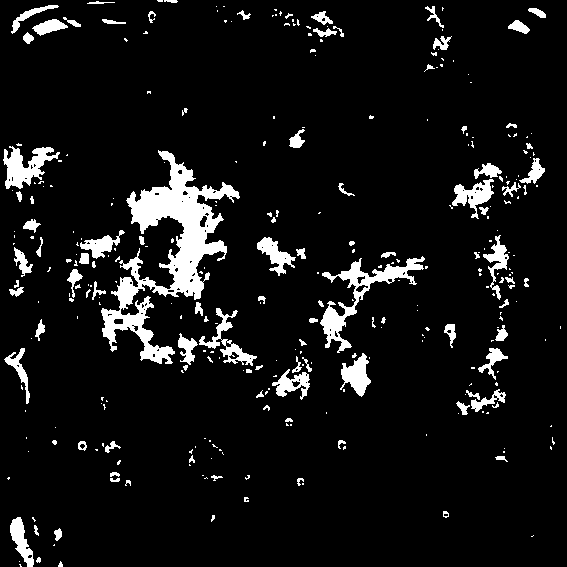Silica sand grain graduation non-alkali glass batch
A technology of alkali-free glass and batching materials, which is applied in glass forming, glass manufacturing equipment, manufacturing tools, etc. It can solve the problems of silica sand particle agglomeration and achieve the effects of small bubble diameter, cost saving and simple process
- Summary
- Abstract
- Description
- Claims
- Application Information
AI Technical Summary
Problems solved by technology
Method used
Image
Examples
Embodiment 1
[0017] 1. 59% SiO by mass percentage 2 , 17% Al 2 o 3 , 0.2% ZrO 2 , 5% CaO, 7% B 2 o 3 , 3% MgO, 6.55% SrO, and 1.8% P 2 o 5 , 0.15% SnO, 0.15% MoO 3 , 0.15% WO 3 For batching, select silica sand particles with a particle size greater than 0.15mm for silica;
[0018] 2. Put the prepared raw materials into a ball mill for mixing and grinding, and the ball milling time is controlled at 0.25-0.5h to mix the raw materials evenly to obtain a uniform mixture;
[0019] 3. Melt the mixture obtained in step 2 in a melting furnace: the melting furnace is raised from room temperature to 1100°C for 2 hours; then it is raised from 1100°C to 1640°C for 3 hours and kept for 2 hours to obtain glass liquid;
[0020] 4. The molten glass obtained by melting enters the tin bath and is cast into shape by the iron plate casting method;
[0021] 5. Anneal the formed glass sample in an annealing kiln, keep it warm at 700°C for 0.5~1h, cool the glass sample to room temperature with the fur...
Embodiment 2
[0023] 1. 59% SiO by mass percentage 2 , 17% Al 2 o 3 , 0.2% ZrO 2 , 5% CaO, 7% B 2 o 3 , 3% MgO, 6.55% SrO, and 1.8% P 2 o 5 , 0.15% SnO, 0.15% MoO 3 , 0.15% WO 3 For batching, select silica sand particles with a particle size of 0.075-0.15mm for silica;
[0024] 2. Put the prepared raw materials into a ball mill for mixing and grinding, and the ball milling time is controlled at 0.25-0.5h to mix the raw materials evenly to obtain a uniform mixture;
[0025] 3. Melt the mixture obtained in step 2 in a melting furnace: the melting furnace is raised from room temperature to 1100°C for 2 hours; then it is raised from 1100°C to 1640°C for 3 hours and kept for 2 hours to obtain glass liquid;
[0026] 4. The molten glass obtained by melting enters the tin bath and is cast into shape by the iron plate casting method;
[0027] 5. Anneal the formed glass sample in an annealing kiln, keep it warm at 700°C for 0.5~1h, cool the glass sample to room temperature with the furnace...
Embodiment 3
[0029] 1. 59% SiO by mass percentage 2 , 17% Al 2 o 3 , 0.2% ZrO 2 , 5% CaO, 7% B 2 o 3 , 3% MgO, 6.55% SrO, and 1.8% P 2 o 5 , 0.15% SnO, 0.15% MoO 3 , 0.15% WO 3 For batching, select silica sand particles with a particle size of less than 0.075mm for silica;
[0030] 2. Put the prepared raw materials into a ball mill for mixing and grinding, and the ball milling time is controlled at 0.25-0.5h to mix the raw materials evenly to obtain a uniform mixture;
[0031] 3. Melt the mixture obtained in step 2 in a melting furnace: the melting furnace is raised from room temperature to 1100°C for 2 hours; then it is raised from 1100°C to 1640°C for 3 hours and kept for 2 hours to obtain glass liquid;
[0032] 4. The molten glass obtained by melting enters the tin bath and is cast into shape by the iron plate casting method;
[0033] 5. Anneal the formed glass sample in an annealing kiln, keep it warm at 700°C for 0.5~1h, cool the glass sample to room temperature with the fu...
PUM
| Property | Measurement | Unit |
|---|---|---|
| particle diameter | aaaaa | aaaaa |
| particle diameter | aaaaa | aaaaa |
| particle diameter | aaaaa | aaaaa |
Abstract
Description
Claims
Application Information
 Login to View More
Login to View More - R&D
- Intellectual Property
- Life Sciences
- Materials
- Tech Scout
- Unparalleled Data Quality
- Higher Quality Content
- 60% Fewer Hallucinations
Browse by: Latest US Patents, China's latest patents, Technical Efficacy Thesaurus, Application Domain, Technology Topic, Popular Technical Reports.
© 2025 PatSnap. All rights reserved.Legal|Privacy policy|Modern Slavery Act Transparency Statement|Sitemap|About US| Contact US: help@patsnap.com



